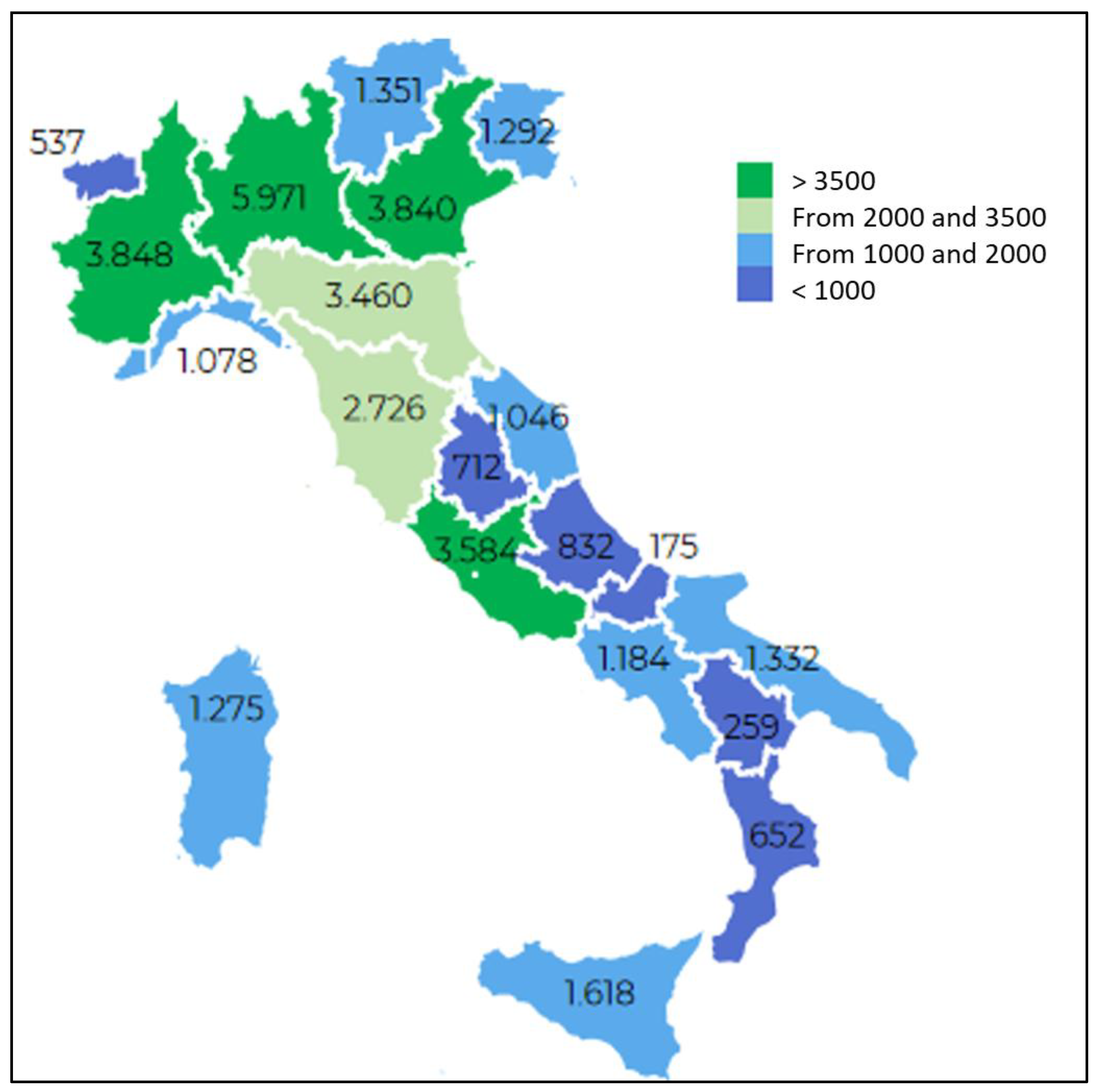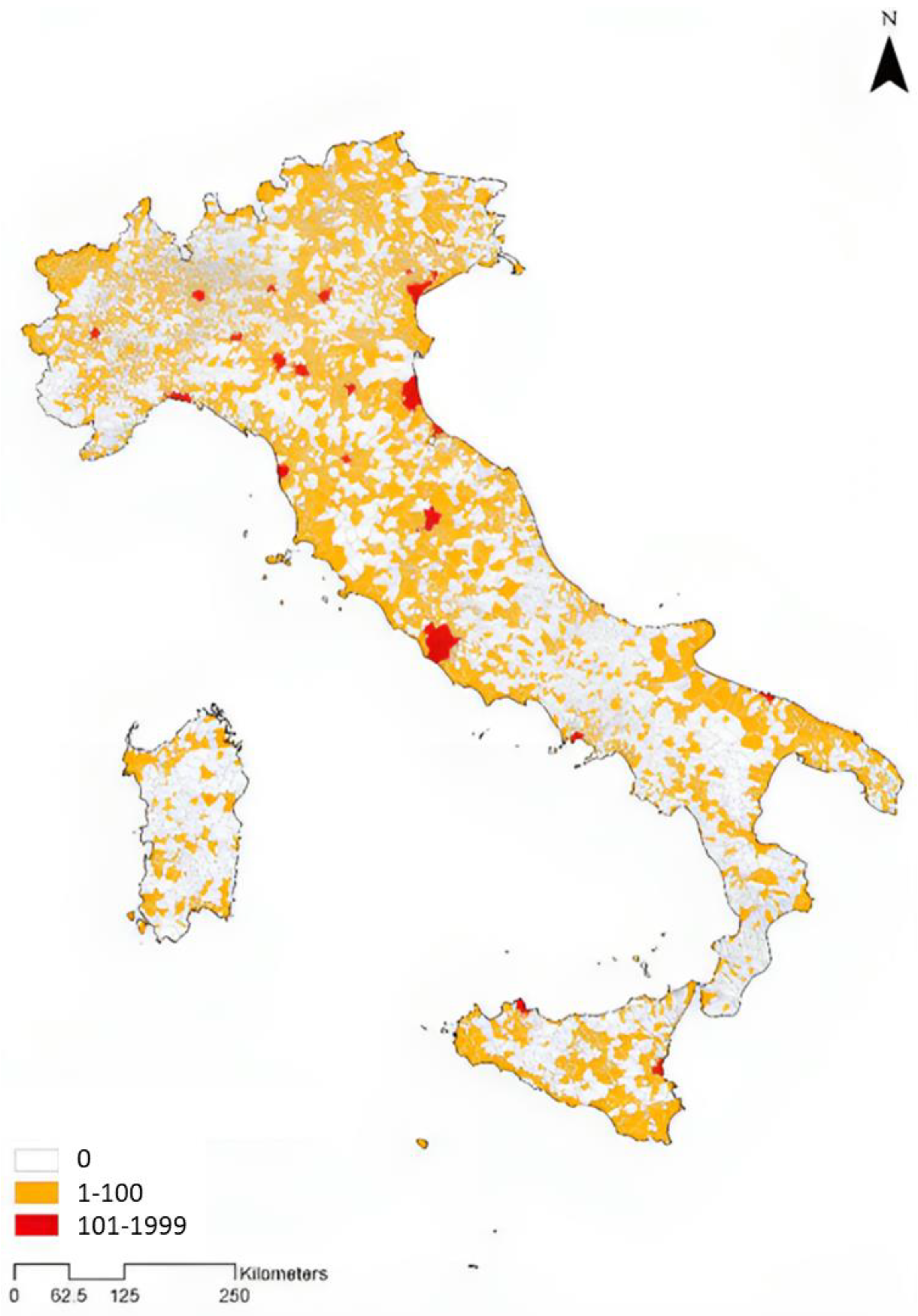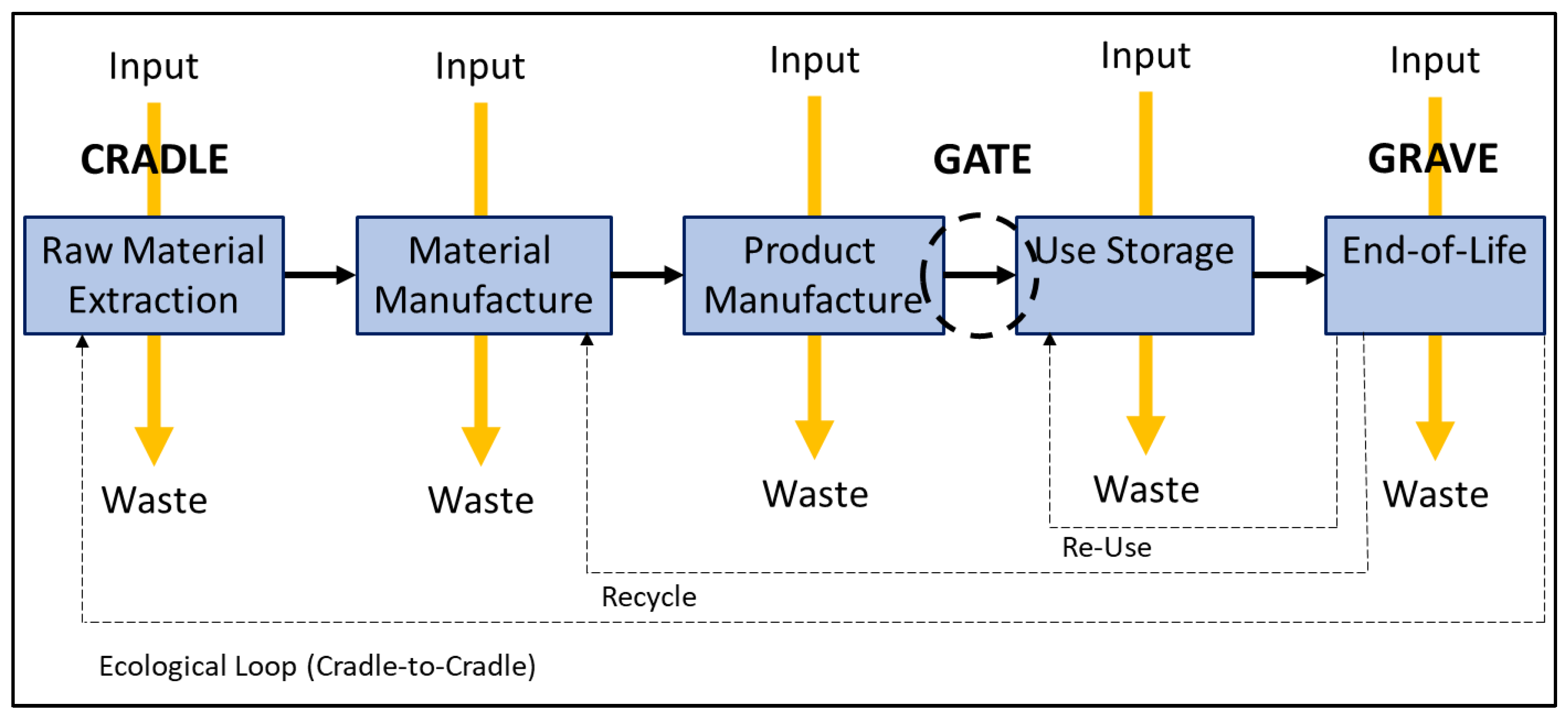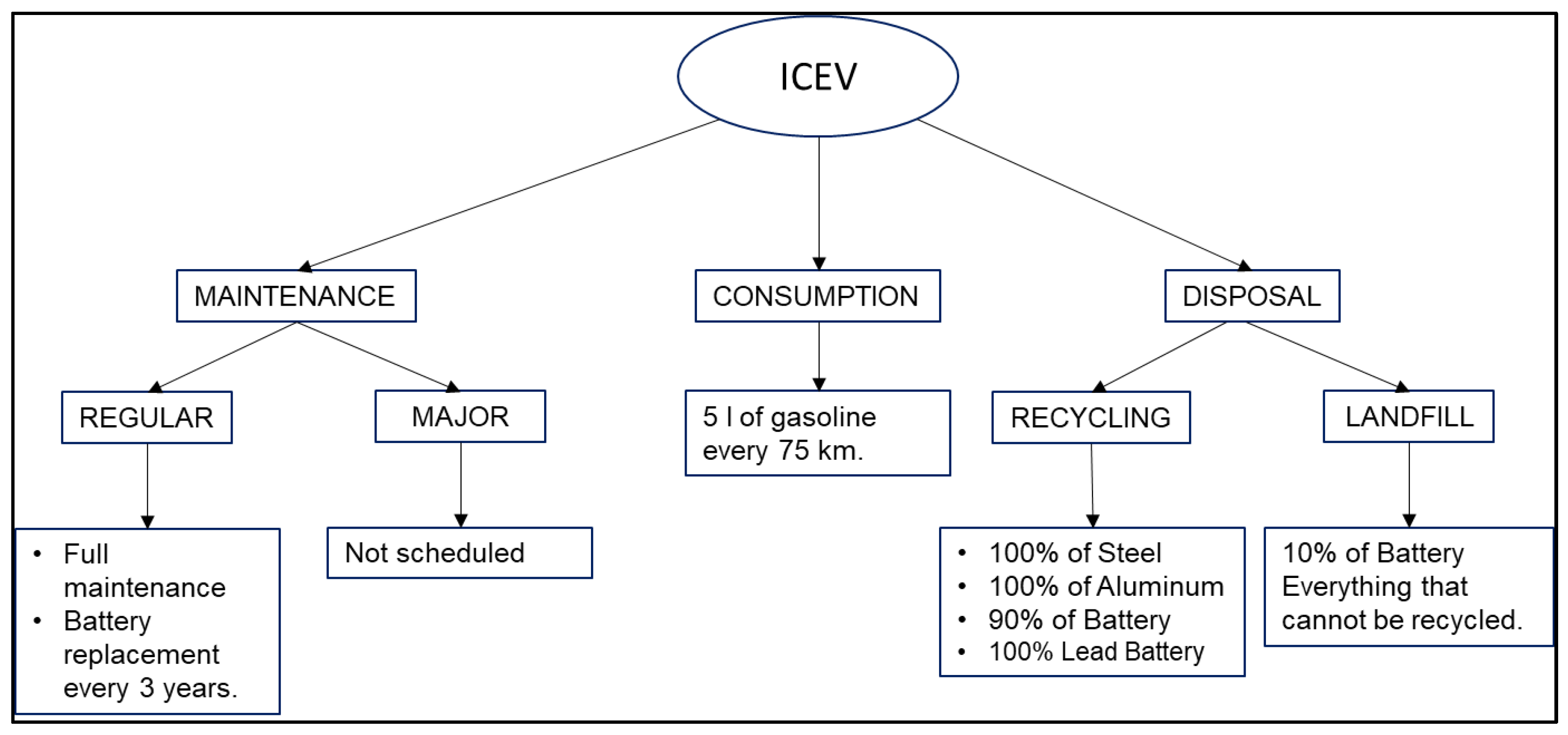Electrifying Green Logistics: A Comparative Life Cycle Assessment of Electric and Internal Combustion Engine Vehicles
Abstract
:1. Introduction
- RQ1: Is it possible to make freight transportation sustainable through electric machinery?
- RQ2: How much does the production of electric energy contribute to the impact of electric vehicles?
- RQ3: Does an electric vehicle truly have a lower environmental impact compared to a gasoline vehicle?
2. Literature Review
3. Methodology: Life Cycle Assessment
- Defining the goal and scope.
- Compiling the Life Cycle Inventory.
- Assessing the potential environmental impacts associated with these inputs and outputs.
- Interpreting the results obtained during the inventory analysis phase and estimating their impact in relation to the study’s objectives.
3.1. Goal and Scope
- Cradle to gate: This analysis begins by considering the extraction and processing of raw materials, which, through successive transformations, yield semi-finished products. It then encompasses the production and/or assembly phase of the product, concluding when the company introduces it to the market.
- Gate to gate: This intermediate phase starts when the semi-finished products enter the factory and ends when the finished product exits, ready for distribution in the market.
- Cradle to grave: Through this analysis, the life cycle of the product or service under examination is analysed, starting from the recovery of raw materials to its end-of-life stage. Throughout this process, the product can follow various paths: reuse of waste within the same production process, landfill disposal, use for energy recovery through incineration, and recycling of certain components for the production of the same product or others.
- Zero burden: With this fourth type of analysis, waste is considered from the moment it becomes waste until, through appropriate processes and treatments, the material ceases to be waste and gains a new life.
3.2. Life Cycle Inventory
3.3. Life Cycle Impact Assessment
- -
- Selection of impact indicators, indicators, and characterization models;
- -
- Attribution of LCI results to the selected impact categories (classification);
- -
- Calculation of indicator results (characterization).
3.4. Interpretation Analysis
- -
- Identification: analysing and comparing data from the earlier stages of the LCA with what was specified in the objective definition.
- -
- Evaluation: verifying the completeness of data and results, conducting sensitivity analyses to analyse the effects on the final outcome, and ensuring consistency to confirm the correspondence between the obtained results and the predefined objectives.
- -
- Conclusions, recommendations, and final report: the results are disclosed, and conclusions are drawn regarding any improvement actions to be taken based on the findings.
4. Case Study: BEV versus ICEV
4.1. Battery Electric Vehicle Using Lithium-Ion Battery Technology (BEV)
- The number of recharges required over a 10-year period to cover 11,200 km, equivalent to 1493.3 recharges, was considered, given the 75 km range per charge.
- The electrical energy consumed to recharge the battery in a period of 3 h, with an 8 A load and a nominal voltage of 230 V, was calculated, resulting in a total of 5520 W power supply.
- By multiplying the number of recharges over 10 years by the electrical energy consumed in a single recharge, a value of 8243 kWh was obtained.
4.2. Internal Combustion Engine Vehicle (ICEV)
4.3. Analysis and Results
5. Discussion
6. Conclusions
Author Contributions
Funding
Data Availability Statement
Conflicts of Interest
References
- EEA Key Findings–Climate Change, Impacts and Vulnerability in Europe 2016; European Environment Agency: Copenhagen, Denmark, 2016.
- Horowitz, C.A. Paris Agreement. Int. Leg. Mater. 2016, 55, 740–755. [Google Scholar] [CrossRef]
- EU Commission Regulation (EU). 1119 of the European Parliament and of the Council of 30 June 2021 Establishing the Framework for Achieving Climate Neutrality. Off. J. Eur. Union 2021, L243, 1–17. [Google Scholar]
- Hofer, C.; Jäger, G.; Füllsack, M. Large Scale Simulation of CO2 Emissions Caused by Urban Car Traffic: An Agent-Based Network Approach. J. Clean. Prod. 2018, 183, 1–10. [Google Scholar] [CrossRef]
- Keller, V.; Lyseng, B.; Wade, C.; Scholtysik, S.; Fowler, M.; Donald, J.; Palmer-Wilson, K.; Robertson, B.; Wild, P.; Rowe, A. Electricity System and Emission Impact of Direct and Indirect Electrification of Heavy-Duty Transportation. Energy 2019, 172, 740–751. [Google Scholar] [CrossRef]
- Du, H.; Chen, Z.; Peng, B.; Southworth, F.; Ma, S.; Wang, Y. What Drives CO2 Emissions from the Transport Sector? A Linkage Analysis. Energy 2019, 175, 195–204. [Google Scholar] [CrossRef]
- Mobility 2030: Meeting the Challenges to Sustainability; World Business Council for Sustainable Development: New York, NY, USA, 2004; Available online: https://www.wbcsd.org/Programs/Cities-and-Mobility/Sustainable-Cities/City-Business-Collaboration/SiMPlify/Resources/Mobility-2030-Meeting-the-challenges-to-sustainability-Executive-Summary-2004 (accessed on 16 October 2023).
- Infographic—Fit for 55: Why the EU Is Toughening CO2 Emission Standards for Cars and Vans. Available online: https://www.Consilium.Europa.Eu/En/Infographics/Fit-for-55-Emissions-Cars-and-Vans/ (accessed on 16 October 2023).
- Documento di Descrizione Degli Scenari 2022; Terna e Snam: Rome, Italy, 2022.
- Powell, S.; Cezar, G.V.; Min, L.; Azevedo, I.M.L.; Rajagopal, R. Charging Infrastructure Access and Operation to Reduce the Grid Impacts of Deep Electric Vehicle Adoption. Nat. Energy 2022, 7, 932–945. [Google Scholar] [CrossRef]
- Motus-E News. Available online: https://www.Motus-e.Org/ (accessed on 16 October 2023).
- Le Infrastrutture di Ricarica a Uso Pubblico in Italia. 2022. Available online: https://www.Motus-e.Org/ (accessed on 16 October 2023).
- Nordelöf, A.; Messagie, M.; Tillman, A.M.; Ljunggren Söderman, M.; Van Mierlo, J. Environmental Impacts of Hybrid, Plug-in Hybrid, and Battery Electric Vehicles–What Can We Learn from Life Cycle Assessment? Int. J. Life Cycle Assess. 2014, 19, 1866–1890. [Google Scholar] [CrossRef]
- Qiao, Q.; Zhao, F.; Liu, Z.; Hao, H.; He, X.; Przesmitzki, S.V.; Amer, A.A. Life Cycle Cost and GHG Emission Benefits of Electric Vehicles in China. Transp. Res. D Transp. Environ. 2020, 86, 102418. [Google Scholar] [CrossRef]
- MacLean, H.L.; Lave, L.B. Life Cycle Assessment of Automobile/Fuel Options. Environ. Sci. Technol. 2003, 37, 5445–5452. [Google Scholar] [CrossRef]
- UNECE. Climate Change and Sustainable Transport; UNECE: Geneva, Switzerland, 2015. [Google Scholar]
- Tagliaferri, C.; Evangelisti, S.; Acconcia, F.; Domenech, T.; Ekins, P.; Barletta, D.; Lettieri, P. Life Cycle Assessment of Future Electric and Hybrid Vehicles: A Cradle-to-Grave Systems Engineering Approach. Chem. Eng. Res. Des. 2016, 112, 298–309. [Google Scholar] [CrossRef]
- Girardi, P.; Gargiulo, A.; Brambilla, P.C. A Comparative LCA of an Electric Vehicle and an Internal Combustion Engine Vehicle Using the Appropriate Power Mix: The Italian Case Study. Int. J. Life Cycle Assess. 2015, 20, 1127–1142. [Google Scholar] [CrossRef]
- Gao, L.; Winfield, Z.C. Life Cycle Assessment of Environmental and Economic Impacts of Advanced Vehicles. Energies 2012, 5, 605–620. [Google Scholar] [CrossRef]
- Messagie, M.; Boureima, F.; Matheys, J.; Sergeant, N.; Turcksin, L.; Macharis, C.; Van Mierlo, J. Life Cycle Assessment of Conventional and Alternative Small Passenger Vehicles in Belgium. In Proceedings of the 2010 IEEE Vehicle Power and Propulsion Conference, VPPC 2010, Lille, France, 1–3 September 2010. [Google Scholar]
- Puig-Samper Naranjo, G.; Bolonio, D.; Ortega, M.F.; García-Martínez, M.J. Comparative Life Cycle Assessment of Conventional, Electric and Hybrid Passenger Vehicles in Spain. J. Clean. Prod. 2021, 291, 125883. [Google Scholar] [CrossRef]
- Xia, X.; Li, P. A Review of the Life Cycle Assessment of Electric Vehicles: Considering the Influence of Batteries. Sci. Total Environ. 2022, 814, 152870. [Google Scholar] [CrossRef]
- Shen, K.; Zhai, Q.; Gu, Y.; Wang, W.; Cao, H.; Hauschild, M.; Yuan, C. Life Cycle Assessment of Lithium Ion Battery from Water-Based Manufacturing for Electric Vehicles. Resour. Conserv. Recycl. 2023, 198, 107152. [Google Scholar] [CrossRef]
- Rosenberg, S.; Kurz, L.; Huster, S.; Wehrstein, S.; Kiemel, S.; Schultmann, F.; Reichert, F.; Wörner, R.; Glöser-Chahoud, S. Combining Dynamic Material Flow Analysis and Life Cycle Assessment to Evaluate Environmental Benefits of Recycling—A Case Study for Direct and Hydrometallurgical Closed-Loop Recycling of Electric Vehicle Battery Systems. Resour. Conserv. Recycl. 2023, 198, 107145. [Google Scholar] [CrossRef]
- Helmers, E.; Weiss, M. Advances and Critical Aspects in the Life-Cycle Assessment of Battery Electric Cars. Energy Emiss. Control Technol. 2017, 5, 1–18. [Google Scholar] [CrossRef]
- Althaus, H.J. Modern Individual Mobility. Int. J. Life Cycle Assess. 2012, 17, 267–269. [Google Scholar] [CrossRef]
- Wolf, M.-A.; Pant, R.; Chomkhamsri, K.; Sala, S.; Pennington, D. The International Reference Life Cycle Data System (ILCD) Handbook; Publications Office of the European Union: Luxembourg, 2012. [Google Scholar]
- ISO. ISO 14040:2006. Available online: https://www.iso.org/standard/37456.html (accessed on 15 November 2023).
- ISO. ISO 14044:2006. Available online: https://www.iso.org/standard/38498.html (accessed on 15 November 2023).
- ISO. ISO 14047:2012. Available online: https://www.iso.org/standard/57109.html (accessed on 15 November 2023).
- ISO. ISO/TS 14048:2002. Available online: https://www.iso.org/standard/29872.html (accessed on 15 November 2023).
- ISO. ISO/TR 14049:2012. Available online: https://www.iso.org/standard/57110.html (accessed on 15 November 2023).
- ISO. ISO 14050:2020. Available online: https://www.iso.org/standard/75300.html (accessed on 15 November 2023).
- Citroen Ami Datasheet. Available online: https://www.Citroen.It/Ami (accessed on 2 September 2023).
- Honda Zoomer Datasheet. Available online: https://www.japan-webike.It/HONDA/ZOOMER+Ruckus+NPS50/74/m-spec/ (accessed on 2 September 2023).
- International Energy Agency. IEA World Energy Statistics and Balances; OECD Publishing: Paris, France, 2017. [Google Scholar]
- EN. EN 15804:2012. Available online: https://www.en-standard.eu/ (accessed on 15 November 2023).
- Hawkins, T.R.; Singh, B.; Majeau-Bettez, G.; Strømman, A.H. Comparative Environmental Life Cycle Assessment of Conventional and Electric Vehicles. J. Ind. Ecol. 2013, 17, 53–64. [Google Scholar] [CrossRef]
- Xia, X.; Li, P.; Xia, Z.; Wu, R.; Cheng, Y. Life Cycle Carbon Footprint of Electric Vehicles in Different Countries: A Review. Sep. Purif. Technol. 2022, 301, 122063. [Google Scholar] [CrossRef]








| ISO n. | Title of International Standard/Guideline/Technical Report |
|---|---|
| [28] | Environmental management—Life cycle assessment—Principles and framework |
| [29] | Environmental management—Life cycle assessment—Requirements and guidelines |
| [30] | Environmental management—Life cycle assessment—Illustrative examples on how to apply ISO 14044 [29] to impact assessment situations |
| [31] | Environmental management—Life cycle assessment—Data documentation format |
| [32] | Environmental management—Life cycle assessment—Illustrative examples on how to apply ISO 14044 [29] to goal and scope definition and inventory analysis |
| [33] | Environmental management—Life cycle assessment—Vocabulary |
| BEV | ICEV | |
|---|---|---|
| Power | 6 kW | 3 kW |
| Torque | 625 Nm | 4.5 Nm @ 5000 rpm |
| Cubic Capacity | NA | 50 cc |
| Battery Capacity | 5.5 kWh | NA |
| Charging Time | 3 h | NA |
| Range | 75 km (After 3 h of charging) | 75 km (With 1 L of fuel) |
| Maximum speed | 45 km/h | 45 km/h |
| Total Weight | 478 kg | 87 kg |
| Storage Weight | 140 kg | 25 kg |
| BEV | ICEV | |
|---|---|---|
| Repair times | 43 | 3 |
| Number of Lead/Acid batteries replaced | 2 | 2 |
| Consumption | 8240 kWh | 1490 kg of gasoline |
| Plastic replaced | 34.9 kg | NA |
| BEV | ICEV | |
|---|---|---|
| Plastic recycled | 122 kg | NA |
| Li batteries recycled | 110 kg | NA |
| Battery, Lead/Acid, recycled | 40.2 kg | 7.5 kg |
| Aluminium recycled | 175 kg | 30.2 kg |
| Steel recycled | NA | 31.9 kg |
| Li batteries disposed in landfill | 12.2 kg | NA |
| Other materials in landfill | 140 kg | 19.07 kg |
| Transport, freight, lorry | 30 km | 30 km |
| Number | Type | Weight/ Consumption | Phase |
|---|---|---|---|
| 1 | BEV | 471 kg | Life cycle |
| 2 | Maintenance electric passenger car | 3 times | Transport |
| 3 | Battery cell, Li-Ion | 122 kg | Material |
| 4 | Plastic flake | 34.9 | Material |
| 5 | Battery, Lead/Acid, Rechargeable | 40.2 kg | Material |
| 6 | Electricity, low voltage (IT) | 8240 kWh | Energy |
| 7 | Recycled aluminium | 175 kg | Disposal process |
| 8 | Transport, freight, lorry | 30 km × kg | Transport |
| 9 | Aluminium in car shredder residue | 175 kg | Disposal process |
| 10 | Battery cell, Li-ion | 122 kg | Disposal process |
| 11 | Battery cell, Li-ion | 110 kg | Recycling process |
| 12 | Used Li-ion battery | 12.2 kg | Disposal process (landfill) |
| 13 | Recycled plastic | 122 kg | Disposal process |
| 14 | Waste Poliethylene for recycling, sorted | 122 kg | Recycling process |
| 15 | Landfill | 87.3 kg | Disposal process (landfill) |
| 16 | Municipal solid waste | 87.3 kg | Disposal process (landfill) |
| 17 | Battery, Lead/Acid, Rechargeable | 40.2 kg | Disposal process |
| 18 | Recycled Battery, Lead/Acid | 40.2 kg | Recycling process |
| Number | Type | Weight/ Consumption | Phase |
|---|---|---|---|
| 1 | ICEV | 87 kg | Life cycle |
| 2 | Maintenance motor scooter | 3 times | Transport |
| 3 | Battery, Lead/Acid, Rechargeable | 7.5 kg | Material |
| 4 | Petrol, unleaded | 1490 kg | Material |
| 5 | Battery, Lead/Acid, Rechargeable | 7.5 kg | Disposal process |
| 6 | Transport, freight, lorry | 30 km × kg | Transport |
| 7 | Battery, Lead/Acid, Rechargeable | 7.5 kg | Recycling process |
| 8 | Landfill | 19.3 kg | Disposal process (landfill) |
| 9 | Municipal solid waste | 19.3 kg | Disposal process (landfill) |
| 10 | Recycled steel | 31.9 kg | Disposal process |
| 11 | Steel, low-alloyed | 31.9 kg | Recycling process |
| 12 | Recycled aluminium | 30.2 kg | Disposal process |
| 13 | Aluminium in car shredder residue | 30.2 kg | Recycling process |
| Impact Category | BEV | BEV + PS | ICEVs (Six) | Unit |
|---|---|---|---|---|
| Climate change | 6418.58 | 3190.00 | 8744.92 | kg CO2 eq |
| Ozone depletion | 0.00072 | 0.00029 | 0.0079 | kg CFC11 eq |
| Ionising radiation | 488.15 | 83.30 | 2294.61 | kBq U-235 eq |
| Photochemical ozone formation | 211.32 | 206.00 | 42.11 | kg NMVOC eq |
| Acidification | 48.65 | 35.60 | 76.42 | mol H+ eq |
| Ecotoxicity, freshwater | 373,791.19 | 331,000.00 | 302,805.68 | CTUe |
| Resource use, fossils | 96,728.22 | 52,900.00 | 506,381.90 | MJ |
| Resource use, minerals and metals | 2.64 | 2.63 | 0.07 | kg Sb eq |
Disclaimer/Publisher’s Note: The statements, opinions and data contained in all publications are solely those of the individual author(s) and contributor(s) and not of MDPI and/or the editor(s). MDPI and/or the editor(s) disclaim responsibility for any injury to people or property resulting from any ideas, methods, instructions or products referred to in the content. |
© 2023 by the authors. Licensee MDPI, Basel, Switzerland. This article is an open access article distributed under the terms and conditions of the Creative Commons Attribution (CC BY) license (https://creativecommons.org/licenses/by/4.0/).
Share and Cite
Oliveri, L.M.; D’Urso, D.; Trapani, N.; Chiacchio, F. Electrifying Green Logistics: A Comparative Life Cycle Assessment of Electric and Internal Combustion Engine Vehicles. Energies 2023, 16, 7688. https://doi.org/10.3390/en16237688
Oliveri LM, D’Urso D, Trapani N, Chiacchio F. Electrifying Green Logistics: A Comparative Life Cycle Assessment of Electric and Internal Combustion Engine Vehicles. Energies. 2023; 16(23):7688. https://doi.org/10.3390/en16237688
Chicago/Turabian StyleOliveri, Ludovica Maria, Diego D’Urso, Natalia Trapani, and Ferdinando Chiacchio. 2023. "Electrifying Green Logistics: A Comparative Life Cycle Assessment of Electric and Internal Combustion Engine Vehicles" Energies 16, no. 23: 7688. https://doi.org/10.3390/en16237688
APA StyleOliveri, L. M., D’Urso, D., Trapani, N., & Chiacchio, F. (2023). Electrifying Green Logistics: A Comparative Life Cycle Assessment of Electric and Internal Combustion Engine Vehicles. Energies, 16(23), 7688. https://doi.org/10.3390/en16237688







